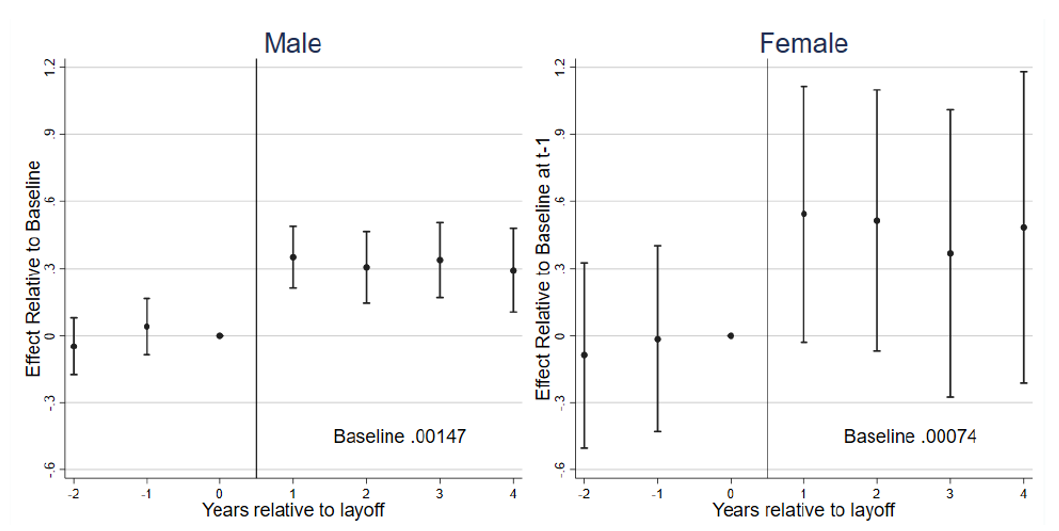
Job losses, through reduced income and increased exposure, lead to substantial increases in domestic violence against women which are not mitigated by unemployment benefits
Domestic violence against women is rampant, affecting one third of women worldwide (World Health Organisation 2013). In the wake of the Covid crisis, evidence has revealed that this situation has only worsened for women in many countries, and recent work has begun to piece together the significant overall costs that domestic violence imposes on society. For example, it has been shown to reduce women’s labour force participation (Siddique 2022 – see VoxDev column).
It is therefore crucial to understand the underlying factors that can lead to domestic violence, and to identify new initiatives that may curb it. In a recent paper (Bhalotra et al. 2021), we study how job losses for men and women affect domestic violence, and whether access to unemployment insurance transfers mitigates any effects. It has been widely documented that job loss leads to large and persistent income losses in the family (e.g. see Britto et al. 2022, Couch and Placzek 2010, Jacobson et al. 1993). We investigate whether income loss is a mechanism driving domestic violence, and we consider an increase in time off work as another potential mechanism.
Our study focuses on Brazil and investigates this question using, for the first time, nation-wide individual-level data on employment outcomes and domestic violence. To address endogeneity concerns, we focus on mass layoffs so that job terminations are arguably driven by firm-level factors. More specifically, we use a difference-in-differences design comparing the incidence of domestic violence for workers displaced in mass layoffs during 2012-2014, relative to a control group composed of similar workers not displaced in the same period.
What is the effect of male and female job loss on domestic violence?
We find that if an individual loses their job, there is an increase in domestic violence in the household as measured by the yearly probability of judicial prosecutions against men and protective measures requested by women (see Figure 1). These effects are large and persistent over time. In the four years after layoff, domestic violence increases by 32% after men lose their jobs, and by 56% after women lose their jobs, relative to the incidence of domestic violence in the year before layoff (in statistical terms these effect sizes do not differ by gender). They are in line with the fact that job loss reduces labour income by about 40% in the four years after displacement. In addition, we document that these incomes losses are not compensated by higher spousal labour supply, which is barely affected.
Figure 1: The effects of male and female job loss on domestic violence

Note: The figure shows the effect of job loss on domestic violence, as measured by the yearly probability of judicial prosecutions against men and protective measures requested by women. The baseline indicates the probability of domestic violence in the year before job loss.
Interestingly, prominent theories of domestic violence cannot explain these findings. They generally focus on the relative position of men and women in the household, and predict that domestic violence should move in opposite directions when men and women lose their jobs. In a household bargaining model, domestic violence increases with the bargaining power of the male partner relative to the female partner (e.g. see Aizer 2010, Anderberg et al. 2016). The model predicts more domestic violence after the woman loses her job and – in contrast with our findings – less domestic violence after the man loses his job. Other prominent models predict exactly the opposite patterns and cannot account for our findings – for example, the male backlash (Macmillan and Gartner 1999) and instrumental control and sabotage models (Bloch and Rao 2002, Anderberg and Rainer 2013).
What can explain the surge in domestic violence after men and women lose their jobs?
We argue that two different mechanisms can explain our findings: income and exposure. First, job loss results in lower income and consumption by the partner losing the job (see Gerard and Naritomi 2021, and Ganong and Noel 2019, for consumption patterns after job loss). This economic crunch can lead to stress and conflict within the household, which may manifest in domestic violence – the income mechanism. The idea that job loss leads to higher stress is supported by an existing literature (Buller et al. 2018, Clark et al. 2008, Zimmerman 2006). Consistent with the income mechanism, we show that high-tenure workers who receive large severance payments upon dismissal experience a much milder increase in domestic violence after job loss.
Second, job loss increases the potential time that partners spend together, which increases the risk of violence, particularly during the stressful period of unemployment – we label this the exposure mechanism (Dugan et al. 2003).
Does access to unemployment benefits reduce domestic violence?
Next, we analyse the impacts of access to unemployment insurance (UI); in this part of the analysis we focus on male job loss only, due to data constraints. This is extremely relevant from a policy perspective – unemployment insurance is the main policy supporting displaced workers around the globe. Our analysis of UI provides additional evidence that both the income and exposure mechanisms play a role in explaining our findings. On the one hand, UI transfers should reduce domestic violence because there is more income and consumption in the household, leading to lower stress. On the other hand, it is well known that UI increases unemployment duration because it generates lower incentives for job search (Katz and Meyer 1990, Card et al.2007, Lalive 2008, Gerard and Gonzaga 2021). Longer unemployment duration potentially increases the time that partners spend together, increasing the risk of domestic violence through the exposure mechanism. Hence, the overall impact of UI transfers on domestic violence depends on which of the two forces – income and exposure – dominates while workers are receiving the transfers. After UI benefits expire, only the exposure mechanism remains active as workers are still less likely to be employed, and UI benefits may backfire.
This is precisely what we find in the data. We estimate the effect of access to unemployment benefits using a clean regression discontinuity design. Specifically, we compare workers who were barely eligible and ineligible for 3-5 months of UI benefits due to small variations in dismissal dates. This is shown in Figure 2, where workers to the right of the cutoff are eligible for unemployment benefits. Access to UI benefits does not affect domestic violence in the first semester after job loss, while workers are receiving the benefits (Figure 2, left panel). After UI expires, we observe an increase in domestic violence in the second semester and three years after job loss (Figure 2, center and right panels). This can be explained by the persistence in lower employment rates among UI recipients.
Figure 2: The effects of access to unemployment benefits on domestic violence, different periods after layoff

Note: The figure shows the effect of access to unemployment benefits on domestic violence, as measured by the probability of judicial prosecutions and protective measures in different periods after job loss. The graph shows how the probability of domestic violence varies across the cutoff allowing displaced workers to access unemployment benefits. Workers to the right of the cutoff are eligible for unemployment benefits while those to the left are not.
Overall, our evidence indicates that the large surge in domestic violence after layoff can be explained both by income losses and higher exposure to domestic violence following job displacement. We provide extensive robustness analysis validating our main findings. For instance, we show that the observed increases in violence after job losses hold for alternative measures of domestic violence that are less prone to reporting issues. In addition, we show that our findings are not driven by spillovers from mass layoffs across displaced workers – they hold even for regular layoffs or relatively small mass layoffs, where fewer workers are displaced at the same time.
Implications for policy
Our work has two key policy implications. First, it calls for policies aimed at preventing domestic violence for families where one of the partners loses a job. The increase we find is large and persistent, and equally relevant when either partner loses their job. Second, UI policies replacing part of the income losses brought by job loss may fail to prevent the increase in domestic violence because they increase the length of unemployment and domestic violence exposure. They may have a better chance of reducing domestic violence if coupled with psychological support or other measures that reduce exposure such as participation in (effective) training or job placement programs.
References
Aizer, A (2010), “The Gender Wage Gap and Domestic Violence", American Economic Review 100(4): 1847-1859.
Anderberg, D and H Rainer (2013), “Economic abuse: A theory of intrahousehold sabotage", Journal of Public Economics 97: 282-295.
Anderberg, D, H Rainer, J Wadsworth and T Wilson (2016), “Unemployment and Domestic Violence: Theory and Evidence", Economic Journal 126(597): 1947-1979.
Bhalotra, S, D Britto, P Pinotti and B Sampaio (2021), “Job Displacement, Unemployment Benefits and Domestic Violence”, CEPR Press Discussion Paper No. 16350.
Buller, A M, A Peterman, M Ranganathan, A Bleile, M Hidrobo and L Heise (2018), “A mixed-method review of cash transfers and intimate partner violence in low-and middle-income countries", The World Bank Research Observer 33(2): 218-258.
Card, D, R Chetty and A Weber (2007), “Cash-on-Hand and Competing Models of Intertemporal Behavior: New Evidence from the Labor Market", The Quarterly Journal of Economics 122(4): 1511-1560.
Couch, K A and D W Placzek (2010), “Earnings losses of displaced workers revisited", American Economic Review 100(1): 572-589.
Dugan, L, D S Nagin and R Rosenfeld (2003), “Exposure Reduction or Retaliation? The Effects of Domestic Violence Resources on Intimate- Partner Homicide", Law & Society Review 37(1): 169-198.
Ganong, P and P Noel (2019), “Consumer spending during unemployment: Positive and normative implications", American Economic Review 109(7): 2383-2424.
Gerard, F and G Gonzaga (2021), “Informal Labor and the Efficiency Cost of Social Programs: Evidence from the Brazilian Unemployment Insurance Program", American Economic Journal: Economic Policy, forthcoming.
Gerard, F and J Naritomi (2021), “Job displacement insurance and (the lack of) consumption-smoothing." American Economic Review 111(3): 899-942.
Jacobson, L S, R J LaLonde and D G Sullivan (1993), “Earnings losses of displaced workers", American Economic Review 685-709.
Katz, L F and B D Meyer (1990), “The impact of the potential duration of unemployment benefits on the duration of unemployment", Journal of Public Economics 41(1): 45-72.
Siddique, Z (2022), "Media-Reported Violence and Female Labor Supply" Economic Development and Cultural Change 70(4).
World Health Organisation (2013), “Global and regional estimates of violence against women: Prevalence and health effects of intimate partner violence and non-partner sexual violence”.
Zimmerman, S D (2006), “Job displacement and stress-related health outcomes", Health Economics 15(10): 1061-1075.




